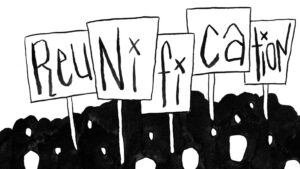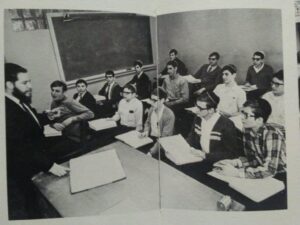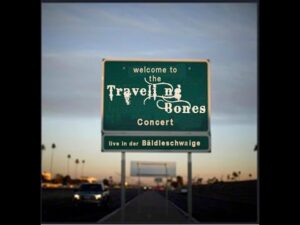Raboyseyee and Ladies,
Reunifications & Traveling Bones:
Welcome to Parshas Vayichi, where we say goodbye to Yaakov, to Yoisef, and according to some, even to Eisav. As we close out Sefer Bereishis, things are looking up for the clan. Yaakov and Yoisef have -after 22 years- been reunited and have had some quality time together. As well, Yoisef and his brothers are now on speaking terms. Whether or not they ever fully reconciled, or, whether or not, there was reconciliation -with or without forgiveness- is not certain. Various medroshim pontificate over this matter. As well, one year ago on this very parsha, the heylige Ois penned and posted an explosive piece titled ‘Reconciliation Without Forgiveness.’ Many commented on it and wrote -or told me in person- that it had an impact on their lives. It’s mamish kiday (well worth your time) to read it again; find it here. https://oisvorfer.com/vayichi-2023-reconciliation-without-forgiveness/
Though we were taught that the heylige story is not a story book nor a history book, it is rather a book of mitzvis, let’s get real: Sefer Bereishis has but three mitzvis -yes, and let us count them: Procreation, bris milah, and not eating the gid hanasheh. Mamish but 3 out of the 613 and zeh-hu (that’s it)? Yes! The rest are in fact foundational stories but stories nonetheless. Let’s get real: didn’t you enjoy reading how Chava was seduced by the snake, how Loit was seduced by his own daughters, how Dina was raped, and how Mrs. Potiphar tried to seduce Yoisef? Of course you did! And didn’t you just love reading about Yehuda’s roadside encounter with what he thought was a hooker? And of Reuvain mounting his mother’s bed? Indeed you did, Were any of these mitzvis? The heylige Ois thinks not! Bereishis contains many a story of broken relationships, disputes and worse between brothers and among family members. The good news: kimat all had happy endings, especially so for Loit, and Yehudah, if you chap. A few parshas back, Yaakov and Eisav reconciled as did Yitzchok and Yishmoel. Uncle Avrohom waged war to save his nephew Loit and it was avada nice to read about family feuds being resolved. On the other hand, Kayin and Hevel never had closure as Hevel was dead having been killed by his own brother. Shoin.
We have -in this most exhilarating book (sefer)- met and bid adieu to many a Toirah character, ober not worry: as you well know, they all come alive -even Hevel- yearly when Sefer Bereishis is read. Some – as in Avrohom and Soro- appear even out of season and we read the electrifying stories -the akeydo and of Soro’s pregnancy over Rosh Hashono. The bottom line: Meeting up with people from our past is especially thrilling.
And taka, this week, the Ois will lead with his own story of his past and a reunification after 53 full years. As mentioned last week, the heylige Ois and eishes chayil spent a week in the Miami area, ober what was not mentioned was one of the most amazing encounters the Ois has had in many years. Back in the fall of 1969 and through June of 1970, the future Ois was a student at Yeshiva Bais Moshe over in Scranton, PA. There I shared a dorm room with two others, one my age and one a year or two older. And why is the Ois leading with this story? One of my roommates was a nice kid from Washington Heights, let’s call him Yoel, or Joel Lang. That is his real name. I last saw Joel in June of 1970. Though we never ran into each other since 1970, nor spoken by phone, I have mentioned his name many dozens of times over the years as he was a critical player in the Ois’s first boy/girl relationship and here’s what went down.

The yeshiva shared a yard with the local Jewish boys/girl’s day school. Boys inclined towards yeshiva could enroll in the yeshiva, but girls had only out of town options for a Jewish high school. Shoin, after some time in yeshiva, it so happened -as the RBSO willed it – that the Ois met a local girl. From time to time, we’d chap a schmooze in the year and shoin. After a while the young lady -just about 13 years of age- and let’s call her Debbie -that is her name mamish- invited me to walk over on a Friday night. As it happens, it is, or was -at least back then- the minhag for every class to walk over to their individual rebbe’s house for a Friday night tish. Shabbos dinner in the yeshiva’s main building was always followed up by a walk to the rebbe’s house for some singing and snacks. Ober, the Ois was also invited over to Debbie’s house at the same time; what to do? And if that weren’t enough to tackle for a young 14-year-old, there was another issue. Back then, the future Ois wore glasses which had been broken while playing ball in the yard. What to do when one has no money and but one pair of glasses? One improvises and that’s just what I did. I placed a band-aid around the temple of my glasses to hold them together. That band-aid lasted a bunch of months.
Could I walk into Debbie’s house with broken glasses? Could I meet her parents like that? What to do when one is invited to a girl’s house and one has broken glasses? Shoin, when the RBSO wants something to happen, there must be a solution. Inspired by the invite, the Ois turned to his roommate Joel Lang and asked him if I could borrow his glasses. It’s mistama not very often that people borrow or exchange glasses but that night I was desperate and for whatever reason, my roommate Yoel and I exchanged glasses. That night, the Ois could not see very well, but the frames were perfect and certainly presentable as I made my way over to Debbie’s house. Ober what about the rebbe’s house? Again, when the RBSO wills it, there is a solution. So happened that the rebbe’s house was mamish a short two block walk from Debbie’s house and just like that, in the middle of the singing mini-kumzits, the future Ois snuck out and made his way to Debbie’s house. Part two of the story for another time.

As mentioned above, since June of 1970, I have never again seen or spoken to Joel Lang though -as mentioned above- I have very often repeated the story of the rebbe, Debbie, the borrowed glasses and me. All that changed two weeks ago Friday night when I found myself davening at the Carriage House on Collins Avenue and 54 street in Miami Beach. After leading the davening, I was approached by a gentleman whom I know from the Five Towns and he introduced me to another gentleman. I asked the gentleman for his name and he responded with his last name, Lang. There standing before me was the very Joel Lang I had not seen since 1970. Neither of us recognized one another. Overwhelmed, I reminded him how in the spring of 1970, he lent me his glasses so that I would look respectable in my spectacles. Shoin, after 53 years, he had no memory of the event, none! I shared the exciting news with the eishes chayil who has heard the story too many times over the past 36 years. Wait: there’s more. Sunday morning, I returned to shul and there was Joel Lang who asked for my cell number.
Later that day he sent me the picture you see below. Joel shared that after our chance meeting, he called his son in New York and asked him to pull out the 1970 yearbook. And there raboyseyee, the story of the borrowed glasses came back to life even for Joel when he spotted me in the picture with the band aid around my glasses. And that raboyseyee is what I call reunification and closure. Efsher you’re wondering what took place at Debbie’s house? Was there any fallout? Plenty, and do stay tuned as the Ois hopes to cover that part in the coming weeks. It’s amazing.

Shoin speaking of closure, let us close with the last few pisukim of our parsha which close out the book of Bereishis with this storyline:
וַיַּ֤רְא יוֹסֵף֙ לְאֶפְרַ֔יִם בְּנֵ֖י שִׁלֵּשִׁ֑ים גַּ֗ם בְּנֵ֤י מָכִיר֙ בֶּן־מְנַשֶּׁ֔ה יֻלְּד֖וּ עַל־בִּרְכֵּ֥י יוֹסֵֽף׃
Yoisef lived to see children of the third generation of Ephraim; the children of Machir son of Manasseh were likewise born upon Yoisef’s knees.
וַיֹּ֤אמֶר יוֹסֵף֙ אֶל־אֶחָ֔יו אָנֹכִ֖י מֵ֑ת וֵֽאלֹהִ֞ים פָּקֹ֧ד יִפְקֹ֣ד אֶתְכֶ֗ם וְהֶעֱלָ֤ה אֶתְכֶם֙ מִן־הָאָ֣רֶץ הַזֹּ֔את אֶל־הָאָ֕רֶץ אֲשֶׁ֥ר נִשְׁבַּ֛ע לְאַבְרָהָ֥ם לְיִצְחָ֖ק וּֽלְיַעֲקֹֽב׃
At length, Yoisef said to his brothers, “I am about to die. G-d will surely take notice of you and bring you up from this land to the land promised on oath to Abraham, to Isaac, and to Jacob.”
וַיַּשְׁבַּ֣ע יוֹסֵ֔ף אֶת־בְּנֵ֥י יִשְׂרָאֵ֖ל לֵאמֹ֑ר פָּקֹ֨ד יִפְקֹ֤ד אֱלֹהִים֙ אֶתְכֶ֔ם וְהַעֲלִתֶ֥ם אֶת־עַצְמֹתַ֖י מִזֶּֽה׃
So Yoisef made the sons of Israel swear, saying, “When G-d has taken notice of you, you shall carry up my bones from here.”
וַיָּ֣מׇת יוֹסֵ֔ף בֶּן־מֵאָ֥ה וָעֶ֖שֶׂר שָׁנִ֑ים וַיַּחַנְט֣וּ אֹת֔וֹ וַיִּ֥ישֶׂם בָּאָר֖וֹן בְּמִצְרָֽיִם׃
Yoisef died at the age of one hundred and ten years; and he was embalmed and placed in a coffin in Egypt.
Ok, let us review the last words and instructions of our hero and kimat everyone’s favorite Toirah character -about whom books, movies and Broadway shows have been written and produced. Seemingly near death, Yoisef -now on speaking terms with his bothers- left very specific instructions on how his bones should be handled. The instructions stated with specificity that he wanted his bones removed from Egypt and carried into the promised land. Ober, just where were those bones buried until that time? Wasn’t it over 100 years later that the Yiddin were to be freed? According to some, the exact number of years was 139. Were they in a long-term storage facility? Nu, back when I was in yeshiva, we were taught that as the Yiddin were getting ready to leave Mitzrayim -following some extended years of slavery -the exact amount avada in dispute- Moishe went down to the river and miraculously had Yoisef’s bones raised up. According to this medrish and tradition, his bones were resting comfortably somewhere on the river bed. Following some magic by Moishe the bones arose and were then carried out as the Yiddin trekked through the midbar for forty years before finally being buried appropriately. We shall address that below, ober, is that what happened? What exactly happened to Yoisef’s bones upon his passing? Where were they buried for over 100 years? We will come back to that but first, let’s find out where they were buried once the Yiddin arrived to the promised land. And for that raboyseyee, we scroll ahead a few weeks where in Parshas Beshalach we will read this posik (Shmois 13:19):
(19) And Moishe took the bones of Yoisef with him; for he had surely sworn the children of Israel, saying: ‘G-d will surely remember you; and ye shall carry up my bones away hence with you.’ And then? So far so good but for the rest of the story, we take a peek into the heylige Novee (Yehoshua 24: 32-33) where we read this:
(לב) וְאֶת־עַצְמ֣וֹת י֠וֹסֵף אֲשֶׁר־הֶעֱל֨וּ בְנֵי־יִשְׂרָאֵ֥ל ׀ מִמִּצְרַיִם֮ קָבְר֣וּ בִשְׁכֶם֒ בְּחֶלְקַ֣ת הַשָּׂדֶ֗ה אֲשֶׁ֨ר קָנָ֧ה יַעֲקֹ֛ב מֵאֵ֛ת בְּנֵֽי־חֲמ֥וֹר אֲבִֽי־שְׁכֶ֖ם בְּמֵאָ֣ה קְשִׂיטָ֑ה וַיִּֽהְי֥וּ לִבְנֵֽי־יוֹסֵ֖ף לְנַחֲלָֽה׃ (לג) וְאֶלְעָזָ֥ר בֶּֽן־אַהֲרֹ֖ן מֵ֑ת וַיִּקְבְּר֣וּ אֹת֗וֹ בְּגִבְעַת֙ פִּֽינְחָ֣ס בְּנ֔וֹ אֲשֶׁ֥ר נִתַּן־ל֖וֹ בְּהַ֥ר אֶפְרָֽיִם׃
(32) And the bones of Yoisef, which the children of Israel brought up out of Egypt, buried they in Shechem, in the parcel of ground which Jacob bought of the sons of Hamor the father of Shechem for a hundred pieces of money; and they became the inheritance of the children of Yoisef.
(33) And Eleazar the son of Aaron died; and they buried him in the Hill of Phinehas his son, which was given him in mount Ephraim.
And now you know. Ober where taka were his bones from the time of his passing until they were finally interred as described in the heylige Novee? Well, that depends on which pshat talks to you. Let us examine two views and let us chap what happened to him before his body disintegrated and only bones were left behind. And secondly, how was Moishe able to find the location where Yoisef’s coffin had been placed? Says the Bechor Shor that Yoisef’s burial was unique. He was buried in an aron, a casket, and that Yoisef was the first person recorded in the heylige Toirah to have been buried in such a manner. Avada, in our times -and at least here in the USA- this practice is commonplace and hence the coffin industry is far from dead with annual revenues of $656.5 Million. Mamish? So says the heylige Internet and if you believe the internet for other zachin -medical advice, and loshon horo- of course this number must be emes. Ober, that was not the case in antiquity -nor in Israel even in our times- where people were generally buried directly in the ground, or in caves, but not our man Yoisef.
Says the Bechor Shor veyter azoy: Yoisef wanted to be buried in a casket so that his remains could easily be transported back to the land of Israel for interment. Had he been buried directly in the ground, his remains could have deteriorated, or the location of his burial could have been forgotten. Either scenario would have made it very challenging for his brother’s descendants to transport his remains to Israel many years later. Nice, ober where was the casket placed in Egypt? Says the Seforno azoy: Yoisef’s casket was kept above ground for all the years that the Yiddin were enslaved in Egypt. Its location needed to be well known to the people so that they could take it with them when they left Egypt. Case closed? Not! Because says the Rashbam that the casket was buried in the ground, perhaps as we do nowadays. The reason then that his body was placed in a casket was so that when the time came to leave Egypt, it would be easy to remove the casket from the ground, rather than have to remove Yoisef’s decayed remains from the Earth. The bottom line: For both the Seforno and the Rashbam, the casket served a very practical need of allowing Yoisef’s remains to be identifiable and accessible for the journey back to the Land of Israel. Ober, let us circle back to Yoisef’s burial spot while awaiting final transport to the promised land, where was he? As mentioned, in a few weeks -Parshas Beshalach- we will read how Moishe himself carried Yoisef’s bones out of that place. Moishe took “the bones (the remains) of Yoisef” with him to be buried in the land of Israel. The heylige Gemora (Soita 13a/b) provides some amazing color, here we go.
וּמִנַּיִן הָיָה יוֹדֵעַ מֹשֶׁה רַבֵּינוּ הֵיכָן יוֹסֵף קָבוּר? אָמְרוּ: סֶרַח בַּת אָשֵׁר נִשְׁתַּיְּירָה מֵאוֹתוֹ הַדּוֹר. הָלַךְ מֹשֶׁה אֶצְלָהּ, אָמַר לָהּ: כְּלוּם אַתְּ יוֹדַעַת הֵיכָן יוֹסֵף קָבוּר? אָמְרָה לוֹ: אָרוֹן שֶׁל מַתֶּכֶת עָשׂוּ לוֹ מִצְרִים וּקְבָעוּהוּ בְּנִילוּס הַנָּהָר, כְּדֵי שֶׁיִּתְבָּרְכוּ מֵימָיו. הָלַךְ מֹשֶׁה וְעָמַד עַל שְׂפַת נִילוּס, אָמַר לוֹ: יוֹסֵף יוֹסֵף! הִגִּיעַ הָעֵת שֶׁנִּשְׁבַּע הַקָּדוֹשׁ בָּרוּךְ הוּא שֶׁאֲנִי גּוֹאֵל אֶתְכֶם, וְהִגִּיעָה הַשְּׁבוּעָה שֶׁהִשְׁבַּעְתָּ אֶת יִשְׂרָאֵל. אִם אַתָּה מַרְאֶה עַצְמְךָ מוּטָב, אִם לָאו — הֲרֵי אָנוּ מְנוּקִּין מִשְּׁבוּעָתֶךָ. מִיָּד צָף אֲרוֹנוֹ שֶׁל יוֹסֵף.
The heylige Gemora asks: And from where did Moishe our teacher know where Yoisef was buried? The Sages -of the medrish- said azoy: Serach, the daughter of Asher, remained from that generation that initially descended to Egypt with Yaakov. Moishe went to her and said to her: Do you know anything about where Yoisef is buried? She said to him: The Egyptians fashioned a metal casket for him and set it in the Nile [Nilus] River as an augury so that its water would be blessed. Moishe went and stood on the bank of the Nile. He said to Yoisef: Yoisef, Yoisef, the time has arrived about which the Holy One, Blessed be He, took an oath saying that I, i.e., G-d, will redeem you. And the time for fulfillment of the oath that you administered to the Jewish people that they will bury you in Eretz Yisrael has arrived. If you show yourself, it is good, but if not, we are clear from your oath. Immediately, the casket of Yoisef floated to the top of the water. Serach? What’s she doing in this story? Well, blow me down and mamish gishmak! It’s so gishmak, we should also read the entirety of the medrish. Says the Mechilta de Reebe Yishmoel (Mechilta, Beshalach, 2) and other midroshim, azoy: Serach bas Asher, Yaakov’s granddaughter, the longest-living survivor from Yoisef’s generation – and according to some- the person who went directly to Gan Eden (paradise) without having ever died- knew exactly where her Uncle Yoisef’s coffin had been hidden. As a wise old woman -remember that at least another 150 years had passed since Serach told Yaakov that Yoisef was alive- she was able to help Moishe discover the specific location where Yoisef’s bones were to be found, submerged mamish beneath the Nile She told Moishe that the Egyptians put Yoisef into a small metal coffin which they sunk in the Nile. Moishe went and stood by the Nile. He took a table[t] of gold on which he engraved the Tetragrammaton, and throwing it into the Nile, he cried out and said: “Yoisef son of Yaakov! The oath to redeem his children, which the RBSO swore to our father Avrohom, has reached its fulfillment.” Immediately Yoisef’s coffin came up to the surface, and Moishe took it. Wow! Can’t make this stuff up, but could, and did others?
As an aside, there is a machloikes (debate/dispute) among our sages on the reason why the bones of Yoisef were thrown into the river by the Mitzrim (Egyptians). Says the heylige Gemora azoy: the Egyptians, aware that Yoisef had saved the country’s economy, wanted to use Yoisef’s bones as an esoteric element, an amulet, throwing his body into the Nile in a metal chest so that Yoisef’s body would “bless the Nile.” How does that work? Like when some people throw coins into the Fonte de Trevi with the hope that the money in their pockets will multiply. In our religion, we’d all this a segula. Ober, over in the medrish (Midrash Tanchuma) we read azoy: Yosef’s remains were disinterred from his luxurious tomb and thrown into the Nile as an act of disdain by the new Egyptian leader, a revisionist Paroy who blamed Yoisef and the Jews for all their miseries; that rings familiar. Which of these really took place? Ver veyst? Were you there? Shoin, let us assume that his bones were taka in the river and that before leaving Egypt, Moishe took the time to refloat Yoisef’s bones from the bottom of the Nile, carry him and bringing his bones to Israel, why not?
Don’t like this pshat? Let’s try another as did the Gemora which quotes another medrish, one they did not teach us in yeshiva; here we go. The heylige Gemora presents a different version of where Yoisef was buried. Rabbi Noson says: Yoisef was buried in the crypt [kabbarnit] of kings. Moishe went and stood by the crypt of kings and said: Yoisef, the time has arrived about which the Holy One, Blessed be He, took an oath saying that: I will redeem you. And the time for fulfillment of the oath that you administered to the Jewish people that they will bury you in Eretz Yisrael has arrived. If you show yourself, it is good, but if not, we are clear from your oath. At that moment, the casket of Yoisef shook among the caskets. Moishe took it and brought it over to himself. Also gishmak but in this version, Yoisef was buried on dry land. Hard to believe that a casket shook? You believe all other miracles, but this bothers you? Shreklich! Let’s read the Gemora innaveynig:
רַבִּי נָתָן אוֹמֵר: בְּקַבַּרְנִיט שֶׁל מְלָכִים הָיָה קָבוּר. הָלַךְ מֹשֶׁה וְעָמַד עַל קַבַּרְנִיט שֶׁל מְלָכִים, אָמַר: יוֹסֵף, הִגִּיעַ עֵת שֶׁנִּשְׁבַּע הַקָּדוֹשׁ בָּרוּךְ הוּא שֶׁאֲנִי גּוֹאֵל אֶתְכֶם, וְהִגִּיעָה שְׁבוּעָה שֶׁהִשְׁבַּעְתָּ אֶת יִשְׂרָאֵל. אִם אַתָּה מַרְאֶה עַצְמְךָ — מוּטָב, וְאִם לָאו — הֲרֵי אָנוּ מְנוּקִּין מִשְּׁבוּעָתֶךָ. בְּאוֹתָהּ שָׁעָה נִזְדַּעְזַע אֲרוֹנוֹ שֶׁל יוֹסֵף, נְטָלוֹ מֹשֶׁה, וֶהֱבִיאוֹ אֶצְלוֹ.
But all this is nothing when compared to the next shtikel Gemora which deals with Yoisef’s remains being trekked through the midbar. Let’s read that shtikel:
וְכׇל אוֹתָן שָׁנִים שֶׁהָיוּ יִשְׂרָאֵל בַּמִּדְבָּר, הָיוּ שְׁנֵי אֲרוֹנוֹת הַלָּלוּ, אֶחָד שֶׁל מֵת וְאֶחָד שֶׁל שְׁכִינָה, מְהַלְּכִין זֶה עִם זֶה, וְהָיוּ עוֹבְרִין וְשָׁבִין אוֹמְרִים: מָה טִיבָן שֶׁל שְׁנֵי אֲרוֹנוֹת הַלָּלוּ? אָמְרוּ: אֶחָד שֶׁל מֵת וְאֶחָד שֶׁל שְׁכִינָה. וְכִי מָה דַּרְכּוֹ שֶׁל מֵת לְהַלֵּךְ עִם שְׁכִינָה? אָמְרוּ:
And all those years that the Jewish people were in the wilderness, these two arks, one a casket of a dead man, Yoisef, and one the Ark of the Divine Presence, i.e., the Ark of the Covenant, were traveling together, and passersby would say: What is the nature of these two arks? They said to them: One is of a dead person and one is of the Divine Presence. The passersby would ask: And in what way is it the manner of a dead person to travel with the Divine Presence? They said in response: This one, i.e., the deceased Yoisef, fulfilled all that is written in this. Therefore, it is fitting that the two arks should lie side by side.

But wait, there is more information for the Ois to share this week, information he has never seen before. Says the Bechor Shor veyter azoy: quoting the medrish -where of course all is possible- Yoisef’s body was not the only one carried out of Egypt after the long exile. All of Yoisef’s brothers were ultimately buried in the Land of Israel. Each tribe took the remains of their own Patriarch as they left Egypt. Well, blow me down. The only exception was Yoisef’s own tribes, Ephraim and Menashe, since the heylige Toirah tells us bifeirush (in the text (Shmois 13:19) that Moishe himself took the remains of Yoisef out of Egypt. The medrish bases this pshat on the Hebrew word ‘itchem,’ with you, in the posik we read above and repeated here since you already forgot:
וַיַּשְׁבַּ֣ע יוֹסֵ֔ף אֶת־בְּנֵ֥י יִשְׂרָאֵ֖ל לֵאמֹ֑ר פָּקֹ֨ד יִפְקֹ֤ד אֱלֹהִים֙ אֶתְכֶ֔ם וְהַעֲלִתֶ֥ם אֶת־עַצְמֹתַ֖י מִזֶּֽה׃
So Yoisef made the sons of Israel swear, saying, “When G-d has taken notice of you, you shall carry up my bones from here.”
Yoisef tells his brothers, “my body will be transported with your bodies back to Egypt.” And that’s why raboyseyee, the heylige Ois loves the medrish.
Ober, oib azoy (it that’s the case) why doesn’t the heylige Toirah explicitly record anything about the burial of the brothers and their transport to the Land of Israel? That’s none of your business!
The bottom line: as the book of Bereishis comes to a close, Yoisef reminds his brothers, and us, the readers of the heylige Toirah, that despite any honor and fanfare received in the exile, a Jew’s place is always in the Land of Israel. Sadly, recent events have proven Yoisef correct. Is it time to go or at least get ready? Are we seeing a replay of the late 1930’s in Europe? Oy vey!
The final bottom line: was Yoisef’s final resting place and according to one medrish, also the resting place of all his brothers, a reminder that one is not truly at rest until one reaches Israel?
Chazak, Chazak, Vi’nischazake & a Gittin Shabbis!
The Heylige Oisvorfer Ruv
Yitz Grossman
